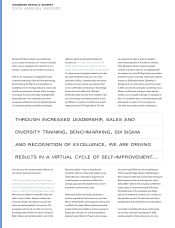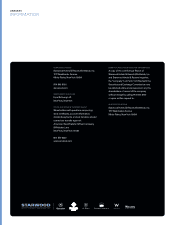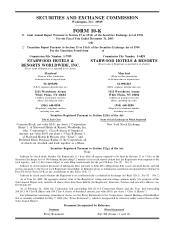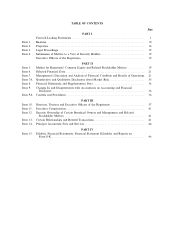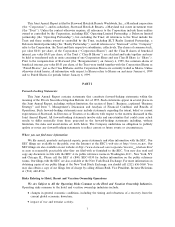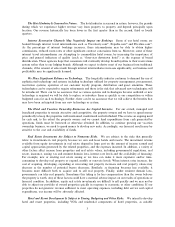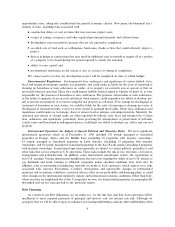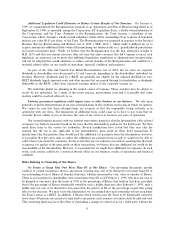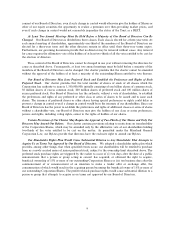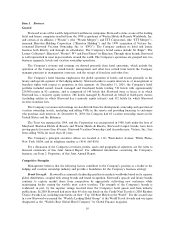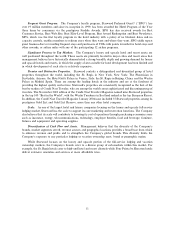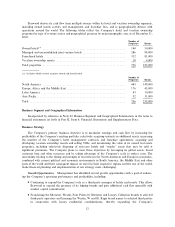Starwood 2003 Annual Report Download - page 14
Download and view the complete annual report
Please find page 14 of the 2003 Starwood annual report below. You can navigate through the pages in the report by either clicking on the pages listed below, or by using the keyword search tool below to find specific information within the annual report.opportunities arise, taking into consideration the general economic climate. New project development has a
number of risks, including risks associated with:
¬construction delays or cost overruns that may increase project costs;
¬receipt of zoning, occupancy and other required governmental permits and authorizations;
¬development costs incurred for projects that are not pursued to completion;
¬so-called acts of God such as earthquakes, hurricanes, Öoods or Ñres that could adversely impact a
project;
¬defects in design or construction that may result in additional costs to remedy or require all or a portion
of a property to be closed during the period required to rectify the situation;
¬ability to raise capital; and
¬governmental restrictions on the nature or size of a project or timing of completion.
We cannot assure you that any development project will be completed on time or within budget.
Environmental Regulations. Environmental laws, ordinances and regulations of various federal, state,
local and foreign governments regulate our properties and could make us liable for the costs of removing or
cleaning up hazardous or toxic substances on, under, or in property we currently own or operate or that we
previously owned or operated. These laws could impose liability without regard to whether we knew of, or were
responsible for, the presence of hazardous or toxic substances. The presence of hazardous or toxic substances,
or the failure to properly clean up such substances when present, could jeopardize our ability to develop, use,
sell or rent the real property or to borrow using the real property as collateral. If we arrange for the disposal or
treatment of hazardous or toxic wastes, we could be liable for the costs of removing or cleaning up wastes at
the disposal or treatment facility, even if we never owned or operated that facility. Other laws, ordinances and
regulations could require us to manage, abate or remove lead or asbestos containing materials. Similarly, the
operation and closure of storage tanks are often regulated by federal, state, local and foreign laws. Certain
laws, ordinances and regulations, particularly those governing the management or preservation of wetlands,
coastal zones and threatened or endangered species, could limit our ability to develop, use, sell or rent our real
property.
International Operations Are Subject to Special Political and Monetary Risks. We have signiÑcant
international operations which as of December 31, 2003 included 176 owned, managed or franchised
properties in Europe, Africa and the Middle East (including 29 properties with majority ownership);
43 owned, managed or franchised properties in Latin America (including 12 properties with majority
ownership); and 92 owned, managed or franchised properties in the Asia PaciÑc region (including 4 properties
with majority ownership). International operations generally are subject to various political, geopolitical, and
other risks that are not present in U.S. operations. These risks include the risk of war, terrorism, civil unrest,
expropriation and nationalization. In addition, some international jurisdictions restrict the repatriation of
non-U.S. earnings. Various international jurisdictions also have laws limiting the ability of non-U.S. entities to
pay dividends and remit earnings to aÇliated companies unless speciÑed conditions have been met. In
addition, sales in international jurisdictions typically are made in local currencies, which subject us to risks
associated with currency Öuctuations. Currency devaluations and unfavorable changes in international
monetary and tax policies could have a material adverse eÅect on our proÑtability and Ñnancing plans, as could
other changes in the international regulatory climate and international economic conditions. Other than Italy,
where our risks are heightened due to the 13 properties we own, our international properties are geographically
diversiÑed and are not concentrated in any particular region.
Debt Financing
As a result of our debt obligations, we are subject to: (i) the risk that cash Öow from operations will be
insuÇcient to meet required payments of principal and interest; and (ii) interest rate risk. Although we
anticipate that we will be able to repay or reÑnance our existing indebtedness and any other indebtedness when
4


